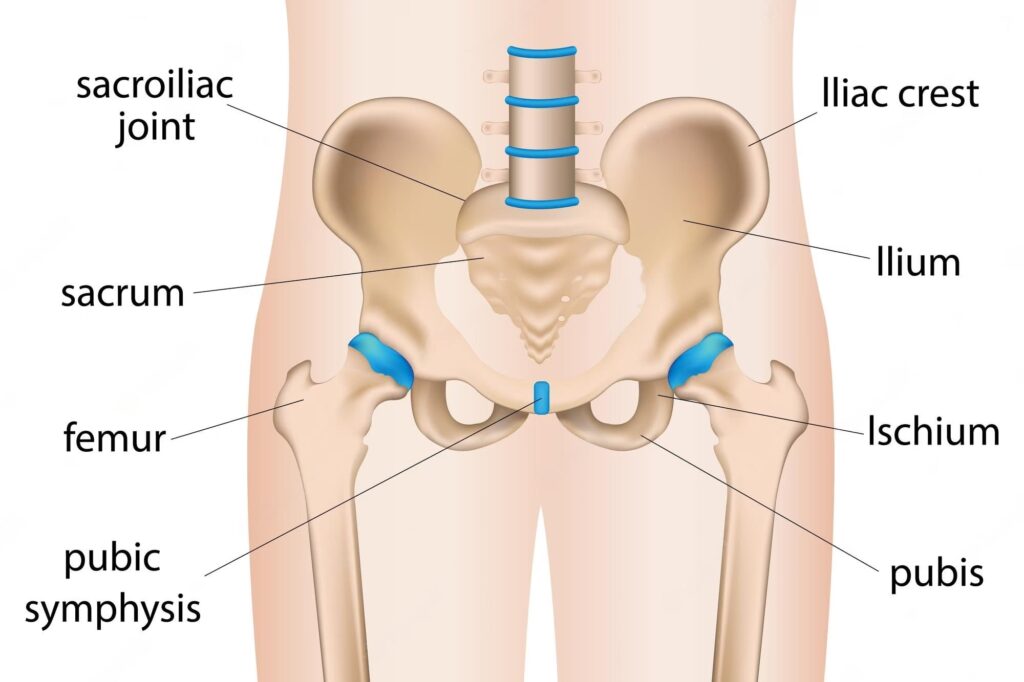The iliac crest is an important part of the human anatomy. It is located on the side of the pelvis, and is made up of a number of bones, muscles, nerves, and vessels. The iliac crest provides stability to our bodies as well as protection from injury. Pain in this area can be indicative of numerous underlying medical conditions and should not be ignored. This guide is intended to provide an overview of iliac crest pain, its causes, symptoms, diagnosis, treatment options and prevention tips.
What is Iliac Crest Pain?
Iliac crest pain can have a number of different causes and may be experienced in any age group. It is sometimes associated with the overuse or sudden strain of the muscles, tendons and ligaments in the area. Traumatic injuries such as falls or car accidents can also cause iliac crest pain. In some cases, it may be caused by medical conditions such as fractures of the pelvis or herniated discs. Nerve compression is another possible cause of iliac crest ache.
Significance of the Iliac Crest
The iliac crest is an important structure for the human body. It is an area where vital nerve bundles, muscles, blood vessels and other structures come together. This makes it a source of stability and protection from injury. Injuries to this area can lead to serious complications such as numbness, paralysis or even organ damage if left untreated
Read More: Vertebrogenic Low Back Pain: Causes, Symptoms, Treatment
Anatomy of the Iliac Crest
Structure and Location
The iliac crest is a curved ridge at the top of the pelvis. It is located on either side of the spine, close to the hip bones. The iliac crest is made up of several bony structures that provide stability and support for our bodies.
Muscles Attached to the Iliac Crest
The muscles attached to the iliac crest include the iliac us, psoas major, gluteus minimus and quadratus lumborum. These muscles work together to help stabilize our body and provide movement of the hip joint.
Nerves and Blood Supply
The iliac crest is also home to several important nerves that control sensation and movement in our lower limbs. These include the femporal nerve, which provides sensation in the lower leg; the obturator nerve, which innervates the hip and thigh muscles; and the lateral femoral cutaneous nerve, which supplies sensation to the thighs. Additionally, there are numerous arteries that provide blood supply to this area.
Read More: How to Settle Stomach Aches: Your Ultimate Guide
Common Causes of Iliac Crest Pain
The most common causes of iliac crest pain include muscle strain, trauma and injuries, nerve compression and medical conditions.
1) Muscle Strain and Overuse
Iliac crest pain can be caused by overuse or sudden strain of the muscles in this area. This is often due to repetitive movements such as lifting heavy objects, running long distances or playing sports. It can also be caused by poor posture or incorrect form when performing activities.
2) Trauma and Injuries
Traumatic injuries such as falls, car accidents and blows to the area can cause iliac crest pain. Injuries to the bones or ligaments in this area can also be a contributing factor.
3) Nerve Compression
The nerves in this area can become compressed, which may lead to pain. This is often caused by herniated discs or other medical conditions that affect the nerves in this area.
4) Medical Conditions
Medical conditions such as fractures of the pelvis, osteoarthritis or rheumatoid arthritis can also cause iliac crest pain. Additionally, some medical procedures such as abdominal surgery can lead to pain in this area.
Read More: Strep Throat While Pregnant: Causes, Symptoms, Treatment
Symptoms of Iliac Crest Pain
The most common symptom of iliac crest pain is a deep, dull ache or throbbing sensation in this area. Depending on the underlying cause of the pain, other symptoms may be present such as swelling, tenderness, muscle spasms or numbness. Pain may worsen with certain activities and feel better after rest.
Iliac crest pain cancer symptoms: In rare cases, iliac crest pain can be a sign of more serious medical conditions such as cancer. Symptoms of cancer-related iliac crest pain may include swelling, redness or warmth in the area, and persistent pain that does not get better with rest or self-care measures. It is important to seek medical help if these symptoms are present.

Diagnosing Iliac Crest Pain
If you experience iliac crest pain, it is important to seek medical help. Your doctor will be able to perform a thorough examination and determine the underlying cause of your symptoms.
Medical History and Physical Examination
Your doctor will take a detailed history of your medical condition including any previous injuries or surgeries in the area as well as any activities that may have triggered the pain. Additionally, they will perform a physical examination to check for any signs of tenderness, swelling or numbness.
Imaging Tests
Your doctor may order imaging tests such as X-rays, MRI scans or CT scans to assess the area and diagnose any underlying medical conditions.
Diagnostic Injections
In some cases, your doctor may recommend a diagnostic injection to confirm the diagnosis and identify the cause of the pain. The injection contains anesthetic or corticosteroid medications that can provide relief from the pain if it is caused by inflammation or muscle strain.
Read More: How to Stop Gout Pain at Night: A Comprehensive Guide
Treatment Options for Iliac Crest Pain
The treatment for iliac crest pain depends on the underlying cause. Your doctor may recommend one or more of the following treatments:
1. Rest and Ice
Rest and ice are often recommended to relieve pain caused by muscle strain, inflammation or trauma. It is important to avoid activities that exacerbate the pain such as lifting heavy objects or running long distances.
2. Physical Therapy
Physical therapy can help strengthen weakened muscles and improve flexibility in the area. Exercises such as stretching, strengthening and low-impact aerobics can help improve mobility and reduce pain.
3. Medications
Over-the-counter anti-inflammatory medications may be recommended to reduce pain and inflammation. In some cases, stronger prescription medications or corticosteroid injections may be prescribed.
Read More: Subscapularis Pain: What Causes It, and How to Relief Pain
4. Injections
In some cases, injections of corticosteroid or anesthetic medications may be recommended to reduce pain and inflammation. This can provide long-term relief from symptoms.
5. Surgery
Surgery may be recommended in cases of severe nerve compression or fractures that do not respond to other treatments. In most cases, surgery is an effective way to reduce pain and improve the function of the area.
Preventing Iliac Crest Pain
Exercises and Stretching
Stretching and strengthening exercises can help reduce the risk of injury and improve the function of the muscles in this area. Exercises such as leg lifts, hip flexors, lateral lunges, bridges and wall squats are all beneficial for strengthening the iliac crest muscles. Additionally, stretching exercises such as pelvic tilts, butterfly stretches and cobra poses can help maintain flexibility in the area.
Wear Appropriate Footwear
Wearing supportive shoes that provide cushioning can help reduce the risk of injury to this area. Additionally, shoes with a low heel can help maintain optimal alignment and improve your balance.
Avoid Repetitive Movements
Repetitive movements such as running long distances or lifting heavy objects can cause strain on the iliac crest muscles. To reduce the risk of injury, it is important to take frequent breaks and avoid over-exertion.
Diet and Nutrition
Eating a balanced diet rich in fruits, vegetables, whole grains and lean protein can help maintain optimal muscle health. Additionally, it is important to drink plenty of water to stay hydrated and reduce the risk of injury.
Read More: Lateral Hip Pain: What Causes It, How to Relief Pain?
Proper Posture and Body Mechanics
It is also important to practice proper posture and body mechanics when performing activities such as lifting heavy objects or sitting for extended periods of time. This helps minimize strain on the muscles and ligaments in this area. Additionally, it is important to pay attention to your body and rest when needed. Listening to your body can help prevent injury and reduce the risk of developing iliac crest pain.
When to See a Doctor
It is important to seek medical help if you experience any of the red flag symptoms such as severe pain, swelling or numbness in this area. Additionally, any signs of infection such as fever, chills or pus should be evaluated by a doctor right away.
If you are experiencing persistent iliac crest ache that does not respond to self-care measures, it is important to see your doctor as soon as possible. They will be able to diagnose the underlying cause of your symptoms and provide an effective treatment plan.
Conclusion
Iliac crest pain can be a debilitating condition, but with the right treatment it is possible to reduce symptoms and improve function in this area. It is important to seek medical help if you experience any red flag symptoms or persistent pain that does not respond to self-care measures. Additionally, exercises such as stretching and strengthening can help reduce the risk of injury and maintain optimal muscle health. With proper care and attention, it is possible to reduce the risk of developing iliac crest pain and maintain optimal health in this area.
Read More: Laser Therapy for Pain: A Beacon of Hope in Alleviating Discomfort
FAQs
Yes, a chiropractor can help with iliac crest pain. Chiropractic treatments such as manipulation and massage may help reduce pain and restore mobility to the area. Additionally, they may recommend specific exercises to improve strength and flexibility in this area.
The length of time it takes for iliac crest pain to go away depends on the underlying cause and treatment plan. In most cases, symptoms can be managed with rest, ice and medications within a few weeks. However, more severe conditions such as fractures or nerve compression may take longer to heal.
Yes, iliac crest pain can cause back pain. The muscles in this area attach to the spine and a strain or injury in this area can cause referred pain to the lower back. Additionally, weak or tight muscles in this area may contribute to poor posture which can further aggravate back pain.
Yes, iliac crest pain can cause groin pain. Groin pain is a common symptom of iliac crest strain or a sports-related injury. Additionally, nerve compression or fractures in this area may cause radiating pain to the groin. It is important to see your doctor for an accurate diagnosis and treatment plan if you are experiencing ongoing groin pain.

